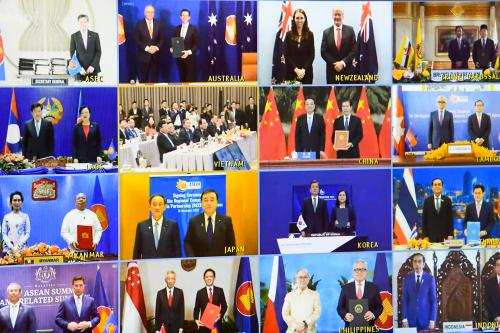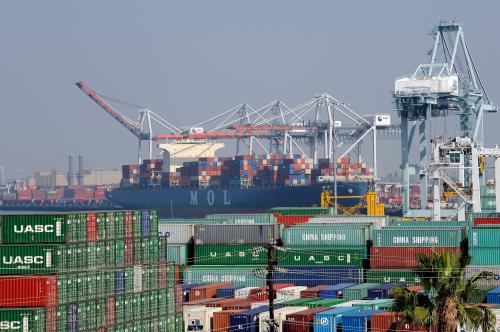Shakers and movers just wrapped up their panels and power networking in Davos, focusing on protectionism, nationalistic populism, income inequality, and geopolitical instability, often willfully ignoring the Pandora’s box of global trade, a phenomenon governments can do little to reverse.
According to U.S. President Donald Trump’s crude and contradictory stance, it is fine to project a zero-sum version of “bilateral trade,” in part by moving to impose tariffs on Chinese washing machines and solar energy cells. It is also fine to then claim just days later from the Davos stage that America First does not mean America alone. Bafflingly, he also hinted the U.S. might return to the Trans-Pacific Partnership free trade agreement if (and only if) America could secure a “substantially better deal.” This left key parties to the deal either scratching their heads or rolling their eyes.
On the one hand, if unbridled protectionism lies ahead, we are going to see a tremendous fall in living standards through higher prices for many basic goods and services. On the other, unless some cold water is thrown on what International Monetary Fund Managing Director Christine Lagarde calls “irrational complacency,” where free trade and unbounded capitalism are embraced during bull markets, those of us in the West may need to accept inequality, populism, and possibly extreme social turbulence and internal destabilization as the “new normal.”
The truth is that global capitalism advances through concentration and centralization of capital, as Karl Marx used to say. And trade is the channel. Global trade also has a critical role in spreading the inexorable fourth industrial revolution and artificial intelligence in particular. Given the power of this latest revolution to transform humanity, it behooves us to harness AI and technology for the greater good and manage its downsides, something World Economic Forum head Klaus Schwab discusses in his book, The Fourth Industrial Revolution.
So is gridlock inevitable? Should we learn to live with the terrible side effects of inequality and populism, furthermore as trade grows, as was predicted by Lagarde in Davos last week?
Pessimism aside, trade is irrevocably good for billions of people in Asia. Many leaders at Davos, including Prime Minister Narendra Modi of India, insisted on multilateral trade with the same rules for all.
Along the same lines, Lagarde emphasized during a CNBC Davos panel that trade rules should be clear, fair, and enforced. Yet even among enthusiasts, the concern that trade, along with the fourth industrial revolution, may lead to a “race to the bottom” in labor and product markets alike, seems broadly shared. It is true that unfettered free trade has become a bonanza for consumers, but it also has become a nightmare for many less-skilled or semi-skilled workers, particularly in most western countries. This fuels societies’ polarization and the rise of nationalistic populism across western countries.
In this context, there has been a call from people like Larry Summers and Kemal Dervis for regulation to alleviate inequalities both within and among nations, but the question of implementation still remains, as no international entity is empowered to right these fundamental disparities.
In any case, as hedge fund manager Ray Dalio said while at Davos, a consensus is emerging that we are 12-24 months away from a new downturn. Given this, it is important to accurately gauge the state of global trade today and to assess what has changed since the great recession of 2007-8.
Figure 1: EU-28 trade by geographical zone, 2008 and 2016 (EUR billion)
From the standpoint of the European Union, Figure 1 depicts the speed of post crisis globalization. The EU’s exports to Asia increased by almost 50 percent, while those to North America rose by around 30 percent.
Figures 2a and 2b show how the situation has changed over the past 10 years or so. Clearly, intra-regional trade surpassed extra-regional, global trade between 1980 and 2006, in contrast to the current dominant trend.
Figure 2a: Regional exports in percent of GDP (Intra-regional exports as percent of GDP)
| 1980 | 1990 | 2000 | 2006 | |
| Europe | 18 | 15.7 | 21.8 | 23.6 |
| North America | 3.2 | 3.4 | 6.1 | 5.9 |
| Asia-Pacific | 6.2 | 7.7 | 11.2 | 17.4 |
| Middle-East | 2.2 | 2.4 | 2.1 | 4.5 |
| Latin America | 3.9 | 2.2 | 4.1 | 5.0 |
| Africa | 1.5 | 1.7 | 3.1 | 3.4 |
Figure 2b: Regional exports in percent of GDP (Extra-regional exports as percent of GDP)
| 1980 | 1990 | 2000 | 2006 | |
| Europe | 6.1 | 5.0 | 7.5 | 7.6 |
| North America | 6.2 | 4.9 | 4.9 | 5.0 |
| Asia-Pacific | 9.6 | 9.5 | 10.8 | 14.7 |
| Middle-East | 44.3 | 25.6 | 32 | 47.2 |
| Latin America | 12.3 | 10.2 | 10.4 | 16.7 |
| Africa | 29 | 19.6 | 26.5 | 26.0 |
Source: World Bank, IMF. Tables taken from Pelagidis et al (2012), Trade flows revisited: further evidence on globalization, Cambridge Journal of Economics, 36, 481–493.
The same can be seen in Figure 4, which shows the ratio of intra-EU exports of goods to extra-EU exports of goods fell steadily since 2003 for all countries in Europe.
Figure 3: Ratio of intra-EU exports of goods to extra-EU exports of goods, 2003, 2009, and 2015
Source: http://ec.europa.eu/eurostat/statistics-explained/index.php/File:Ratio_of_intra-EU_exports_of_goods_to_extra-EU_exports_of_goods,_2003,_2009_and_2015-T-6.png
In the new millennium, global trade outperforms regionalism. Yet, as surely as free trade allowed French President Emmanuel Macron to declare last week in Davos that “Europe is back,” so it is that high growth rates generated from free trade do little to support blue collar workers or counter income inequality. There is currently no way to capture the ebullience in capital markets with respect to inclusive growth.
Multilateral trade is in peril—less because of President Trump’s threats or even his move to slap tariffs on certain Chinese products and more because under-privileged and overlooked populations in western economies will soon realize that even 3 to 4 percent global growth is not working for them. Until then, discussions in fora such as Davos should focus on specific cooperative actions to save modern capitalism from itself.
As World Trade Organization Director General Roberto Azevedo said, “While political support is essential, it is not sufficient. Words need to be matched by deeds. If we believe in multilateralism, we have to be ready to take the steps needed to make it work.”
In this context, the establishment of a Court of International Trade empowered to resolve disputes and deadlocks among countries might help to avert a race-to-the-bottom tariff war or even prevent its flip side, a currency war.






Commentary
Davos 2018: Between optimism and the risks of irrational complacency
January 31, 2018